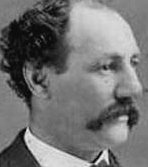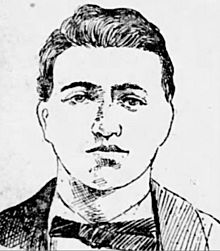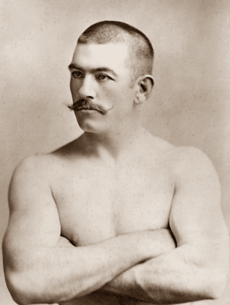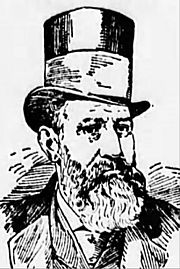Joe Coburn facts for kids
Quick facts for kids Joe Coburn |
|
|---|---|
 |
|
| Statistics | |
| Real name | Joseph Henry Coburn |
| Rated at | 185 lb (84 kg)*, heavyweight division *Early career fought as middleweight weight range, 154-190 |
| Height | 5 ft 9.25 in (1.76 m) Varies downward slightly in records |
| Nationality | Irish American Came to America around 1850 Settled in Queens, NY. |
| Born | 29 July 1835 Middletown County, Armagh, Ireland |
| Died | 6 December 1890 (aged 55) Queens, New York |
| Stance | Orthadox Right handed Used London Prize Ring Rules |
| Boxing record | |
| Total fights | 10 * major professional bouts only |
| Wins | 4 |
| Losses | 2 |
| Draws | 3 |
| No contests | 1 |
Joe Coburn (born July 29, 1835, in Middletown, County Armagh, Ireland – died December 6, 1890, in New York City, New York) was a famous Irish-American boxer. In 1862, he became the Heavyweight Champion. This happened because the previous champion, John Carmel Heenan, would not fight him.
Contents
Joe Coburn's Early Life and Boxing Start
Joe Coburn was born in Ireland on July 29, 1835. His parents were Michael and Mary Trainor. When Joe was about 15, his family moved to America in 1850. They were leaving Ireland during a very difficult time called the Great Irish Famine.
Joe's father was a skilled worker. Joe grew up to be a bricklayer in New York. When he was 21, he was part of the local fire department. His first boxing match in Brooklyn was set up by his co-workers. He won that fight in just four rounds. Later, Joe owned his own tavern, a type of pub, called "The White House." As a boxer, Joe was known for being very quick.
Around 1856, Joe traveled to Boston for a fight. He met Ned Price at Spy Pond. Their fight lasted 100 rounds and three and a half hours! It was called a draw because it got too dark to see. Both boxers needed months to recover from this tough match.
Joe kept fighting and winning. On August 7, 1857, he beat Patsy Flynn in New York. He won in four rounds. Later that year, on November 19, 1857, Joe defeated Harry Gribbin. This fight was for $1,000 for each boxer. He also beat Ben Winkles for another $1,000. The next month, Joe had a practice match with John C. Heenan in New York.
Boxing Rules in Joe Coburn's Time
Boxing in Joe Coburn's era was different from today. Fighters used rules called the London Prize Ring Rules. These rules came from earlier ones by Jack Broughton.
Under these rules, if a boxer fell and could not get up in 30 seconds, the fight ended. It was against the rules to hit a fighter who was already down. Also, hitting below the waist was not allowed. Boxers did not wear gloves in real fights. They only used padded "mufflers" for training.
A unique rule was that a boxer could drop to one knee. This would start a 30-second count. But using this too often was not liked by the judges. By the 1860s, when Joe Coburn was fighting, the rules were a bit more organized. However, bare-knuckle boxing was still very rough.
Becoming American Heavyweight Champion
Joe Coburn first became the heavyweight champion in 1862. This happened because John C. Heenan, who was called the "Benicia Boy," did not agree to fight him. Heenan had tried to win the championship before but failed.
Joe Coburn had two important championship fights that were not stopped. The first was on May 5, 1863. He defended his American title against Mike McCoole. They fought with bare knuckles under the London Prize Ring Rules. The fight lasted one hour and eight minutes! It went for 67 rounds in Charlestown, Maryland. Each boxer had put up $2,500.
McCoole was about 20 pounds heavier than Coburn. But Coburn was still expected to win. Joe seemed to be better from the start. He was thrown down many times. Yet, he landed powerful punches on McCoole's face. In the 63rd round, Joe looked very tired. By the 67th round, McCoole looked "lifeless" and was taken away. This fight was against the law in Maryland.
Later, in 1864, Joe and McCoole tried to fight again. But they were both arrested and spent 40 days in jail.
In late 1865, Joe Coburn challenged Tom King. King was the English heavyweight champion. But King decided to retire from boxing. So, he did not fight Joe.
Around 1865, Joe Coburn traveled to Great Britain. He fought and beat other champions like Joe Goss and Tom Allen. He also beat Bill Rayel. During this tour, Joe weighed around 190 pounds. This was heavier than his earlier fights.
Losing the Championship Title
In 1865, Joe Coburn decided to retire from boxing. He refused to fight Jimmy Elliott for the American Heavyweight Championship. Because he retired, his championship title was officially taken away the next year. But Joe soon decided to return to the boxing ring.
Last Championship Fight Attempt
Joe Coburn came out of retirement in 1871. He wanted to fight Jem Mace for the heavyweight championship again. Many boxing experts believe this fight was for the world championship.
Their first fight was planned for 1864, but Mace did not show up. Joe was very angry because he missed out on a big fight. Their second fight was on November 30, 1871. It took place in Bay St. Louis, Louisiana. Mace hurt his hand in the fifth round. The boxers agreed to stop the fight after the 12th round. This was because of Mace's injury. But it was also raining very hard, and they were fighting in deep mud.
Exhibition Fights with John L. Sullivan
After some time away from boxing, Joe Coburn returned in 1882. He had seven successful exhibition fights with the famous champion John L. Sullivan. These fights happened from December 1882 to March 1883. Joe also had three exhibitions with Herbert Slade in April.
Joe's exhibition with Sullivan on January 20, 1883, was very popular. It filled Buffalo's St. James Hall. They also drew large crowds in Joe's hometown of Troy, New York. Sullivan usually did most of the hard hitting.
Boxing was becoming more accepted. So, the police did not stop these exhibition fights. On March 13, 1883, Joe and Sullivan put on a skilled boxing show. About 4,000 people watched them at Madison Square Garden in New York.
During their exhibition on April 19, 1883, Joe Coburn seemed more skilled than Herbert Slade. This was at the Griswold Opera House in Troy, New York. Some people thought Slade was the better boxer in their exhibition on April 23, 1883. Slade was fast and landed good punches on Joe. Joe looked like he might fall a few times. But it seemed like some parts of the exhibition might have been planned.
Later Life and Legacy
In 2013, Joe Coburn was honored. He was chosen to be in the International Boxing Hall of Fame.
After retiring from professional boxing, Joe continued to manage his Saloon on Broadway.
Joe Coburn's Death
Joe Coburn passed away on December 6, 1890. He died at his home in New York City. He left behind his wife and a two-year-old son. Joe was not wealthy when he died. His friends had raised money to help him just before his death. After a service at his home, he was buried in Calvary Cemetery in Queens, New York.
See also
- List of world heavyweight boxing champions





